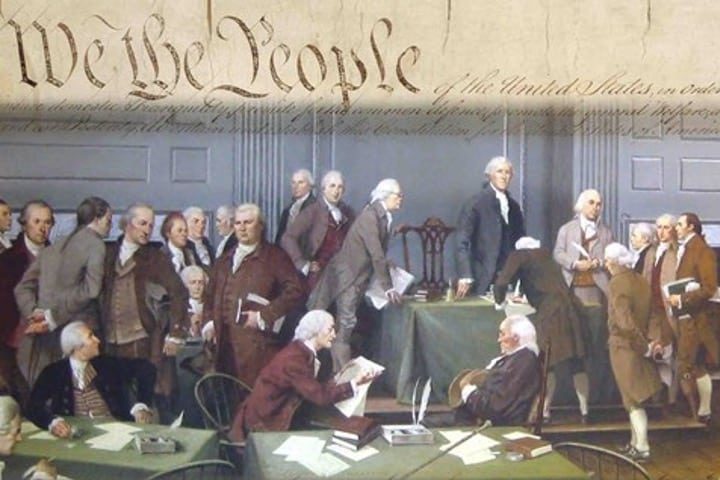
The Constitutional Convention of 1787 was a seminal moment in American history, where the drafters of the United States Constitution deliberated on the structure and principles that would undergird the government of the union. On June 8, 1787, the convention witnessed several significant events that shaped the course of the convention and ultimately the future of the United States.
First, June 8 marked the day when the convention turned its attention to the controversial issue of representation in the proposed general (what we call “federal”) legislature.
The Connecticut Compromise, also known as the Great Compromise, was a pivotal moment during the Constitutional Convention of 1787 held in Philadelphia. Proposed by Roger Sherman and Oliver Ellsworth, delegates from Connecticut, the compromise addressed the thorny issue of representation in the proposed national legislature and played a crucial role in shaping the framework of the United States government.
The debate over representation was a central point of contention between the larger and smaller states at the convention. The Virginia Plan, put forward by Edmund Randolph, favored a bicameral legislature in which representation would be based on population. This plan was met with fierce opposition from the smaller states, who feared their interests would be overshadowed by the more populous states.
Enter the Connecticut Compromise. Sherman and Ellsworth offered a solution that aimed to bridge the gap between the competing interests. Their proposal called for a bicameral legislature as well, but consisting of two chambers — the House of Representatives and the Senate — with different representation.
The House of Representatives would be based on proportional representation, with the number of seats determined by each state’s population. This satisfied the larger states, who sought greater influence in the legislative process.
In contrast, the Senate would provide equal representation to each state regardless of its size or population. Each state, no matter how small, would have an equal voice in the upper chamber. This aspect of the compromise was crucial for the smaller states, as it protected their interests and ensured they would not be marginalized in the general legislature.
The Connecticut Compromise struck a delicate balance between the competing interests of the large and small states, and its adoption proved to be a turning point in the convention. It not only resolved the contentious issue of representation, but also preserved the unity and participation of the 12 states who sent delegates to the convention.
The legacy of the Connecticut Compromise endures to this day, as the bicameral structure it proposed remains a fundamental aspect of the United States Congress.
(Sadly, the power of the states — the creators of the Constitution — was gutted by the Seventeenth Amendment, which repealed Article I, Section 3 of the original Constitution. Thus, the ability of the states to serve as a bulwark against federal tyranny was transferred to the people, in direct contradiction to the principle that compelled delegates at the convention to remain in Philadelphia and finish the work assigned to them.)
Another crucial issue addressed on June 8 was slavery. The institution of slavery had deeply divided the convention, and the question of counting enslaved individuals for the purposes of representation and taxation was a contentious one. The Three-Fifths Compromise emerged as a solution.
Delegates from the Southern states argued that enslaved individuals should be counted as part of the population, thereby increasing their representation in the House. Conversely, delegates from the Northern states objected, arguing that enslaved individuals should not be counted as they were denied basic rights. A compromise was reached, stipulating that each enslaved individual would be counted as three-fifths of a “person” for the purposes of representation and taxation.
The Three-Fifths Compromise was one of the most contentious and morally fraught agreements reached during the Constitutional Convention of 1787.
As noted above, at the heart of the debate was the question of how slaves should be counted when determining a state’s population for the purposes of representation in the House of Representatives and taxation. Southern states, which had a higher slave population than states in the North, advocated for the inclusion of slaves in the population count to bolster their representation. However, Northern states opposed this, arguing that slaves were legally considered property.
The compromise had significant implications for representation in Congress and the distribution of political power.
While the Three-Fifths Compromise was a practical political solution aimed at maintaining the union, many Americans today are ignorant of the reason for counting a slave as three-fifths of a person: It was strictly for the purpose of apportioning representation and taxes. (Ironically, the compromise avoided augmenting the political power of the states with significant slave populations.) At no time during the Constitutional Convention of 1787 did any delegate speak in favor of dehumanizing slaves.
Furthermore, had the slaves not been counted at all — that is to say, as not a person at all — then the power of the slaveholding states would have been reduced further. But given the way this compromise has been taught in textbooks and by teachers at government indoctrination institutions, it is unlikely that this fact will ever be properly understood.
And finally, on June 8 the delegates addressed the New Jersey Plan, which proposed amendments to the Articles of Confederation rather than a complete overhaul. Presented by William Paterson, the New Jersey Plan aimed to preserve the sovereignty and power of the smaller states within the proposed national government.
To the credit of William Paterson, the congressional resolution calling on states to send delegates to the convention set very strict parameters on the purpose of that meeting. That resolution reads:
Resolved that in the opinion of Congress it is expedient that on the second Monday in May next a Convention of delegates who shall have been appointed by the several states be held at Philadelphia for the sole and express purpose of revising the Articles of Confederation and reporting to Congress and the several legislatures such alterations and provisions therein as shall when agreed to in Congress and confirmed by the states render the federal constitution adequate to the exigencies of Government & the preservation of the Union.
Note the limits on the convention delegates’ power: “sole and express purpose of revising the Articles of Confederation.” “Sole and express” means one and only and clearly written down. “Revise” does not mean replace. The New Jersey Plan hewed closest to the authority possessed by the men in Philadelphia that summer of 1787.
The New Jersey Plan called for a unicameral legislature, with each state having an equal vote regardless of its size or population. This structure aimed to protect the smaller states from being dominated by the more populous ones, ensuring that their interests were not overshadowed.
While the plan received support from the smaller states, it faced strong opposition from the larger states, particularly those advocating for proportional representation based on population. Ultimately, the New Jersey Plan was rejected by the convention. However, many of its other proposals, such as the federal government’s power to levy taxes and regulate certain types of commerce, found their way into the final Constitution through subsequent negotiations and compromises.
The New Jersey Plan played a significant role in shaping the discussions and deliberations at the Constitutional Convention. Although it was not adopted in its entirety, it highlighted the concerns and perspectives of the smaller states and contributed to the broader conversation on maintaining state sovereignty while granting the authority expedient for a general government of the union to accomplish its role.
June 8 stands out as a pivotal day in the Constitutional Convention of 1787: The Connecticut Compromise ensured a delicate balance between the interests of the large and small states; the Three-Fifths Compromise, while tragically misunderstood, temporarily addressed the issue of slavery; and the rejection of the New Jersey Plan set the stage for further debate and compromise.
This is the fifth article in our summer series on the 1787 Constitutional Convention.



